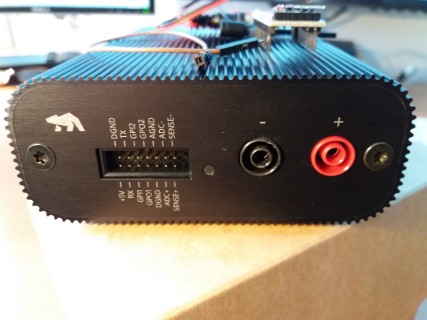Review: Otii Arc demo kit — what’s draining my battery?
Expansion port
 The Otii Arc expansion port permits different measurement set-ups. For example, you can measure at two places on your device at the same time, at system and subsystem level. You connect the main + and - on the Otii Arc to the battery connectors of your device for the system measurements. For subsystem measurements, connect an external sense resistor to the expansion port ADC+ and ADC- and to the test points on your device. Debug logs can be extracted via the (fast) UART for synching with power measurements.
The Otii Arc expansion port permits different measurement set-ups. For example, you can measure at two places on your device at the same time, at system and subsystem level. You connect the main + and - on the Otii Arc to the battery connectors of your device for the system measurements. For subsystem measurements, connect an external sense resistor to the expansion port ADC+ and ADC- and to the test points on your device. Debug logs can be extracted via the (fast) UART for synching with power measurements.
Discuss the problem!
Sharing data on a problem works like a firestarter. Give engineers a riddle (like Thomas did) and they will solve it — the Otii community is relatively new but there’s already great support and tech knowhow to find on the forum. For beginners like me, the Otii Arc boasts a good number of user cases where kits and products from other suppliers were thoroughly investigated in terms of power consumption both useful and stealth. This information is published in the form of blogs and videos on the Qoitech website, like a two-part blog on current consumption secrets of the Cypress PSoC6 BLE Pioneer kit. Or, whatsay, a video on the Samsung S7 smartphone — not quite a teardown but interesting things get revealed there!
 The Otii Arc expansion port permits different measurement set-ups. For example, you can measure at two places on your device at the same time, at system and subsystem level. You connect the main + and - on the Otii Arc to the battery connectors of your device for the system measurements. For subsystem measurements, connect an external sense resistor to the expansion port ADC+ and ADC- and to the test points on your device. Debug logs can be extracted via the (fast) UART for synching with power measurements.
The Otii Arc expansion port permits different measurement set-ups. For example, you can measure at two places on your device at the same time, at system and subsystem level. You connect the main + and - on the Otii Arc to the battery connectors of your device for the system measurements. For subsystem measurements, connect an external sense resistor to the expansion port ADC+ and ADC- and to the test points on your device. Debug logs can be extracted via the (fast) UART for synching with power measurements.
The graphs reveal!
Using the statistics view offered by the GUI you use the scroll, zoom and selection tools to check the power consumptions at a specific time or time interval which can be very revealing. Your debug logs are automatically synced with the selection in the power consumption graph, making it easy to find out what (TF) drains your battery. If you work in a team, measuring, sharing collaboration should be easy. Although I haven’t tested it, I figure you first select what data you want to share by removing single recordings, and by cropping the data to the desired time window. Next, you can save the project and share it with team mates, suppliers or customers. I did not see a cloud-ish environment advertised so the project data probably goes the old fashioned way. The data can be opened with any version of the Otii Software, including the free viewer which I received for this review.Discuss the problem!
Sharing data on a problem works like a firestarter. Give engineers a riddle (like Thomas did) and they will solve it — the Otii community is relatively new but there’s already great support and tech knowhow to find on the forum. For beginners like me, the Otii Arc boasts a good number of user cases where kits and products from other suppliers were thoroughly investigated in terms of power consumption both useful and stealth. This information is published in the form of blogs and videos on the Qoitech website, like a two-part blog on current consumption secrets of the Cypress PSoC6 BLE Pioneer kit. Or, whatsay, a video on the Samsung S7 smartphone — not quite a teardown but interesting things get revealed there!
Read full article
Hide full article

About Jan Buiting
Jan Buiting (1958) has been active in electronics and ways of expressing it since the age of 15. Attempts at educating Jan formally have so far yielded an F-class radio amateur license, an MA degree in English, a Tek Guru award, and various certificates in ele... >>


Discussion (0 comments)